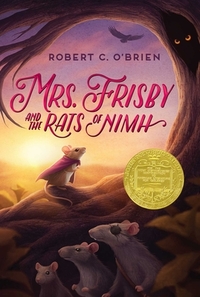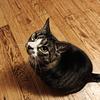Take a photo of a barcode or cover
If I keep watching movies like Ratatouille and reading books like Mrs. Frisby then I’m going to end up buying a pet rat, naming him Rufus or Jucko, and giving him free reign of my house and kitchen. No lies, this is a great read. Quick and easy, but captivating and imaginative. Mrs. Frisby is no rat but is, in fact, a recently widowed mouse. When her youngest son Timothy becomes ill she seeks help from a super-rat-clan. Soon Mrs. Frisby will need to risk everything to save her son… and the rats. I always admire intelligence, even if it comes in rodent form. I’m also a sucker for the “explanations” in books. The whodunit, the thisiswhy, the yes – I-was-once-a-murderer plot themes. Lucky for me – 2/3 of this book is dedicated to back story and explanation. I love that! Basically if you’re enjoy a good story to tell your kids at night – this is it. That’s all.
A great classic, no doubt.
I thought it had a lighter touch and more room for poignant character development than the movie, but I suppose that later part is to be expected. Both the book and movie have a special place in my heart, as well as in my childhood developmental process.
I thought it had a lighter touch and more room for poignant character development than the movie, but I suppose that later part is to be expected. Both the book and movie have a special place in my heart, as well as in my childhood developmental process.
I loved this book when I was younger. Cannot wait to share it with my kids someday
Short Review: I picked this up because I had very vague memories of the movie (which I think I only saw once when it first came out over 30 years ago.) The basic storyline is the same (I went back and looked up the differences after I finished the book). Mrs Frisby is trying to keep her family together when one of her children gets sick. The rats of NIMH are escaped from a lab where they became intelligent and long lived as the result of an experiment. But the movie and book diverge because the movie is about magic and the book is about engineering and social planning.
The book is good and worth reading, but slow. And the slowness is accentuated by a very slow narrator with lots of long pauses.
My full review is on my blog at http://bookwi.se/rats-of-nimh/
The book is good and worth reading, but slow. And the slowness is accentuated by a very slow narrator with lots of long pauses.
My full review is on my blog at http://bookwi.se/rats-of-nimh/
adventurous
challenging
emotional
hopeful
reflective
slow-paced
Plot or Character Driven:
Plot
Strong character development:
No
Loveable characters:
Yes
Diverse cast of characters:
N/A
Flaws of characters a main focus:
No
adventurous
fast-paced
Plot or Character Driven:
Plot
Strong character development:
No
Loveable characters:
Yes
Diverse cast of characters:
Complicated
Flaws of characters a main focus:
No
Mrs. Frisby and the Rats of NIMH is a Newbery award-winning children’s book first published in 1971. Mrs. Frisby is an ordinary widowed field mouse seeking help for her sick son, Timothy, who is at risk due to the looming Moving Day when Farmer Fitzgibbons will plow his field. Along the way she learns that her husband was no ordinary mouse.
When considering any book published over fifty years ago, it’s crucial to consider if it’s still relevant, award-winning or not. Being published in 1971, Mrs. Frisby and the Rats of NIMH certainly reflects its time of origin, published around the same time as other award-winning adult science fiction works with similar themes, such as Flowers for Algernon.
I enjoyed this book even as an adult reader, but I think that it deserves its accolades and is still relevant for a modern audience. I particularly like that it’s more from the perspective of the animals who were genetically engineered and experimented on, allowing children to explore the ethics in an age-appropriate way.
Rating assigned 1/28/2022.
When considering any book published over fifty years ago, it’s crucial to consider if it’s still relevant, award-winning or not. Being published in 1971, Mrs. Frisby and the Rats of NIMH certainly reflects its time of origin, published around the same time as other award-winning adult science fiction works with similar themes, such as Flowers for Algernon.
I enjoyed this book even as an adult reader, but I think that it deserves its accolades and is still relevant for a modern audience. I particularly like that it’s more from the perspective of the animals who were genetically engineered and experimented on, allowing children to explore the ethics in an age-appropriate way.
Rating assigned 1/28/2022.
Very slow through the first 2/3 of the book or so, and even when the action picked up, it was not the enjoyable story i remembered from 5th grade. Granted, that was 26 years ago, but still.
adventurous
funny
hopeful
inspiring
lighthearted
tense
fast-paced
Plot or Character Driven:
A mix
Strong character development:
Yes
Loveable characters:
Yes
Read this with my daughter (10). We had some giggles at the 'science' explanations in the book for how the rats became what they were - though it was written in the 70s and I guess science literacy may not have been what it is today. We enjoyed the story and the characters. I can see why this is classed as a children's classic.


